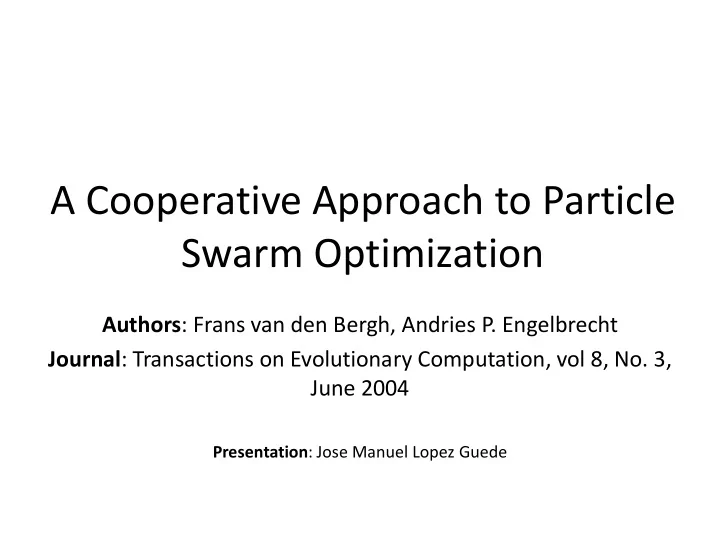

A Cooperative Approach to Particle Swarm Optimization Authors : Frans van den Bergh, Andries P. Engelbrecht Journal : Transactions on Evolutionary Computation, vol 8, No. 3, June 2004 Presentation : Jose Manuel Lopez Guede
Introduction • “Curse of dimensionality” • PSO • CPSO • CPSO-S k • CPSO-H k • GA comparation • Results 2 of 28
Particle Swarm Optimizers I • PSO: – Stochastic optimization technique – Swarm: a population – During each iteration each particle accelerates influenced by: • Its own personal best position • Global best position 3 of 28
Particle Swarm Optimizers II – – • • • 4 of 28
Particle Swarm Optimizers III – During each iteration, each particle is updated: 5 of 28
Particle Swarm Optimizers III – During each iteration, each particle is updated: – The global best position is updated: 6 of 28
Cooperative Learning I • PSO: position Best position of the particle Best position of the swarm – Each particle represents an n-dim vector that can be used as a potential solution. 7 of 28
Cooperative Learning II – Drawback: • Authors show a numerical example where PSO goes to a worst value in an iteration. • Cause: error function is computed only after all the components of the vector have been updated to their new values. – Solution: • Evaluate the error function more frecuently. • For every time a component in the vector has been updated. – New problem: • The evaluation is only possible with a compete vector. 8 of 28
Cooperative Learning III • CPSO-S: – n-dim vectors are partitioned into n swarms of 1-D – Each swarm represents 1 dimension of the problem – “Context vector”: • f requires an n-dim vector • To calculate the context vector for the particles of swarm j, the remainig components are the best values of the remaining swarms. 9 of 28
Cooperative Learning IV context vector 10 of 28
Cooperative Learning V • Advantage: – The error function f is evaluated after each component in the vector is updated. • However: – Some components in the vector could be correlated. – These components should be in the same swarm, since the independent changes made by the different swarms have a detrimental effect on correlated variables. – Swarms of 1-D, and swarms of c-D, taken blindly. 11 of 28
Cooperative Learning VI • CPSO-S k : – Swarms of 1-D, and swarms of c-D, taken blindly, hoping that some correlated variables end up in the same swarm. – Split factor: The vector is split in K parts (swarms) – It is a particular CPSO-S case, where n=K. 12 of 28
Cooperative Learning VII CPSO-S 13 of 28
Cooperative Learning VII – Drawback: • It is possible that the algorithm become trapped in a state where all the swarms are unable to discover better solutions: stagnation. • Authors show an example. 14 of 28
Hybrid CPSOs – CPSO-H k I • Motivation: – CPSO-S k can become trapped. – PSO has the hability to scape from pseudominimizers. – CPSO-S k has faster convergence. • Solution: – Interleave the two algorithms. • Execute CPSO-S k for one iteration, followeb by one iteration of PSO. • Information interchange is a form of cooperation. 15 of 28
CPSO-S k CPSO-S k Overwite 1 particle k of the swarm Q PSO Swarms of the CPSO-S k 16 of 28
Experimental Setup I • Compare the PSO, CSPO-S k , CSPO-H k algorithms. • Measure: #function evaluations. • Several popular functions in the PSO comunity were selected for testing. 17 of 28
Experimental Setup II “all the functions where tested under coordinate rotation using Salomon’s algorithm” 18 of 28
Experimental Setup III • PSO configuration: – All experiments were run 50 times – 10, 15, 20 particles per swarm. – Results reported are averages os the best value in the swarm. Domain: “magnitude to which the initial random particles are scaled” 19 of 28
Experimental Setup IV 20 of 28
Experimental Setup V • GA configuration: 21 of 28
Experimental Setup VI 22 of 28
Results I • Fixed-Iteration Results I – 2.10^5 function evaluations. 23 of 28
Results II • Fixed-Iteration Results II – 2.10^5 function evaluations. 24 of 28
Results III • Fixed-Iteration Results III – PSO-based algs. performed better that GA algs. in general. – Cooperative algorithms collectivelly performed better than the standard PSO in 80% of the cases. 25 of 28
Results IV • Robustness and speed Results I – “ Robustness ”: the algorithm succeed in reducing the the f below a specified threshold using fewer that than a number of evaluations. – “ A robust algorithm ”: one that manages to reach the threshold consistentle (during all runs). 26 of 28
Results V • Robustness and speed Results II 27 of 28
Results VI • Robustness and speed Results III – CPSO-H 6 appears to be the winner because it achieved a perfect score in 7 of 10 cases. – There is a tradeoff between the convergence speed and the robustness of the algorithm. 28 of 28
Recommend
More recommend